vatican
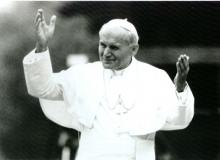
Reports this week that the late Pope John Paul II may be on the verge of sainthood after a second miracle was credited to his intercession aren’t a huge surprise: When he died eight years ago, crowds were already clamoring for his canonization, and Pope Benedict XVI quickly waived the usual five-year waiting period to get the process rolling.
But the news that Pope Francis, just six weeks on the job, has cleared the way for the long-stalled canonization of martyred Salvadoran Archbishop Oscar Romero is a stunner that sends another important signal about the new pope’s priorities.
“Sainthood is often as much about politics and image as anything else,” said the Rev. Harvey Egan, a Jesuit priest and professor emeritus of theology at Boston College.
“It’s not surprising to me that this present pope being from South America, having the same inclinations as Romero, would unblock the process and say ‘Push his cause through,’ and I think rightly so.”

When you’re the pope, few things matter as much as what you say and, especially, where you say it.
From the pulpit of St. Peter’s Basilica or an outdoor altar erected in St. Peter’s Square, popes can command global media attention. Pope Francis, however, has settled in with a smaller congregation for his homilies that’s more in keeping with his low-key style.
Every day at 7 a.m., Francis celebrates Mass in the chapel of the Casa Santa Marta, the Vatican’s hotel-style guesthouse he has chosen to call home instead of the luxurious papal apartments. His brief, colorful homilies are delivered to small groups of Vatican workers, from policemen to doctors and bank employees.
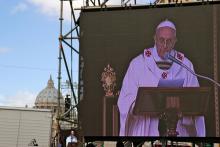
Vatican employees won’t receive the special bonus they are traditionally awarded when a new pope is elected, the Vatican confirmed on Thursday, under orders from Pope Francis to give extra money to charity instead.
“On account of the difficult situation of the general economy, it seemed neither possible nor opportune to burden Vatican institutions with a considerable unforeseen extraordinary expense,” the Vatican’s chief spokesman, the Rev. Federico Lombardi, said in an emailed statement.
In place of the employees’ bonus, Pope Francis ordered Vatican officials to make a donation to some “charitable organizations.”
The money will be drawn from the pontiff’s personal charity budget “as a sign of the church’s attention for the many people who are suffering” from the global economic slowdown, Lombardi said.

Nearly a year after the Vatican announced a makeover of the largest umbrella group for American nuns, Pope Francis has directed that the overhaul of the Leadership Conference of Women Religious continue.
The decision, while not entirely unexpected, could nonetheless bring an end to Francis’ honeymoon with the many American Catholics who had viewed the crackdown on nuns as heavy-handed and unnecessary.
Archbishop Gerhard Ludwig Mueller, who heads the Vatican’s Congregation for the Doctrine of the Faith, met on Monday with the LCWR’s leadership for the first time since Francis’ election on March 13.
According to a Vatican statement, during a recent discussion of the case with Mueller, Francis “reaffirmed the findings” of the Vatican investigation and the “program of reform” for LCWR that was announced on April 18, 2012.
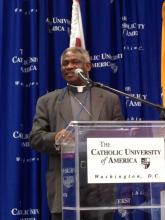
On April 11, 1963 Pope John XXIII published an encyclical some initially dismissed as naive and myopic, as too liberal and too lofty. But today, his "Pacem in Terris" is generally lauded as genius and prophetic – well ahead of its time on the issues of human rights, peace, and equality.
As Maryann Cusimano Love, a Catholic professor of international relations, notes, the same year “Pacem in Terris” was published, spelling out the theological mandate for political and social equality for all people, women in Spain were not allowed to open bank accounts, Nelson Mandela was standing trial for fighting apartheid, and Walter Ciszek was serving time in a Soviet gulag simply for being Catholic.
On Monday and Tuesday, the Catholic Peacebuilding Network hosted a two-day conference at the Catholic University of America, commemorating 50 years since the publication of "Pacem in Terris.”

Wading into one of the most controversial fields of modern medicine, the Vatican is pushing adult stem cell research as ethical and scientifically more promising than embryonic stem cell research.
That’s despite assertions from many in the scientific community that that it’s important to pursue all types of stem cell research, including embryonic, to maximize chances of finding cures for diseases.
Harvesting embryonic stem cells requires the destruction of fertilized embryos — which are considered nascent human life in Catholic doctrine. Adult stem cells can be safely taken from adult human beings.
The Vatican started promoting adult stem cells in 2011, when its Pontifical Council for Culture launched a collaboration with U.S. bio-pharmaceutical company NeoStem.
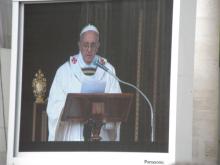
From the very first moment of his unexpected election as Pope Francis, Cardinal Jorge Bergoglio of Argentina has embraced a series of small departures from established tradition.
He took his papal name from a great nonconforming saint of the Middle Ages — and one that no other pope in the history of the Roman Catholic Church has taken. He then refused to stand on an elevated platform that would separate him from his “brother cardinals,” and asked the people of Rome to bless him rather than receive his blessing. He even insisted on returning to his hotel to settle his account (as though his credit were in any doubt).
Everyone who knew Bergoglio saw in him an unconventional and even unpredictable figure. He lived in Buenos Aires in a modest apartment rather than in the archbishop’s palace. He dispensed with a private limousine and took public transportation to work. He even cooked his own meals at home in his own kitchen.
Now, as pope, he has continued this pattern by ignoring long-settled traditions of what a pope should wear, where he should reside, and how he should conduct himself in public functions. Francis has chosen not wear the gold papal cross to which he is entitled, instead wearing the more simple cross he wore in Argentina. He also seems satisfied with normal men’s footwear, avoiding the elegant red loafers Pope Benedict normally wore in public.

Pope Francis has won widespread acclaim thus far in his nascent papacy with popular gestures like washing the feet of juveniles during Holy Week and refusing many papal perks. But now comes the hard part of his new job: reforming the Vatican.
The Roman Curia, as the central administration of the Catholic Church is known, has been riven by scandals and allegations of infighting and careerism, which helped undermine Pope Emeritus Benedict XVI’s reign and reportedly pushed him to resign.
The dysfunction was so bad that reforming the Curia became a rallying cry for many cardinals at the conclave that elected Francis. But will he deliver on the promise of reform?
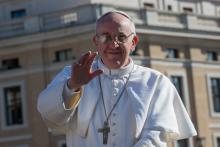
He has been Pope Francis for less than a month, but the keep-it-simple prelate from Argentina is a wow with American Catholics — at least for now.
The tables may turn on Francis once media attention moves from his no-fuss style to his substantive actions, said a Vatican expert Wednesday.
The former archbishop of Buenos Aires has an 84 percent favorable rating among U.S. Catholics, including 43 percent who hold a very favorable view of him, according to a new survey by the Pew Forum on Religion & Public Life.
Pope Francis on Wednesday said women play a “fundamental role” in the Catholic Church as those who are mostly responsible for passing on the faith from one generation to the next.
While the new pope stopped far short of calling for women’s ordination or giving women more decision-making power in the church, his remarks nonetheless signaled an openness to women that’s not often seen in the church hierarchy.
“In the church and in the journey of faith, women have had and still have a special role in opening doors to the Lord,” the Argentine pontiff said during his weekly audience in St. Peter’s Square.
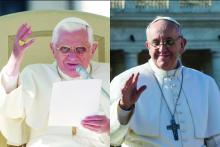
Now that the cardinals have elected and installed their new boss, Pope Francis can get to work being the Roman Catholic pontiff, with his next order of business doing something no other pope has done in centuries: meet the guy he replaced.
Benedict’s resignation — the first by a pope in 600 years — paved the way for the conclave that elected Francis on March 13, but it also created an almost unprecedented potential for confusion and division in a church hierarchy that has room for only one pope at a time.That will happen on Saturday, when Francis is scheduled to travel a few miles outside Rome to the hilltop town of Castel Gandolfo, the summer papal residence where Benedict XVI has been staying — out of sight — since he resigned and left the Vatican on Feb. 28.
“Benedict XVI could turn into a shadow pope who has stepped down but can still exert indirect influence,” said Hans Kung, the dissident Swiss theologian and friend (as well as frequent critic) of Benedict’s since he and the former Joseph Ratzinger were up-and-coming theologians.
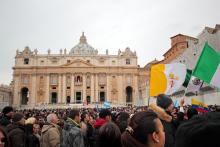
Editor's Note: Pope Francis delivered the following homily at his inaugural Mass on Tuesday, emphasizing the need to protect the poor and the environment.
Dear Brothers and Sisters,
I thank the Lord that I can celebrate this Holy Mass for the inauguration of my Petrine ministry on the solemnity of Saint Joseph, the spouse of the Virgin Mary and the patron of the universal Church. It is a significant coincidence, and it is also the name-day of my venerable predecessor: we are close to him with our prayers, full of affection and gratitude.
I offer a warm greeting to my brother cardinals and bishops, the priests, deacons, men and women religious, and all the lay faithful. I thank the representatives of the other Churches and ecclesial Communities, as well as the representatives of the Jewish community and the other religious communities, for their presence. My cordial greetings go to the Heads of State and Government, the members of the official Delegations from many countries throughout the world, and the Diplomatic Corps.
In the Gospel we heard that "Joseph did as the angel of the Lord commanded him and took Mary as his wife" (Mt 1:24). These words already point to the mission which God entrusts to Joseph: he is to be the custos, the protector. The protector of whom? Of Mary and Jesus; but this protection is then extended to the Church, as Blessed John Paul II pointed out: "Just as Saint Joseph took loving care of Mary and gladly dedicated himself to Jesus Christ’s upbringing, he likewise watches over and protects Christ’s Mystical Body, the Church, of which the Virgin Mary is the exemplar and model" (Redemptoris Custos, 1).
How does Joseph exercise his role as protector? Discreetly, humbly and silently, but with an unfailing presence and utter fidelity, even when he finds it hard to understand. From the time of his betrothal to Mary until the finding of the twelve-year-old Jesus in the Temple of Jerusalem, he is there at every moment with loving care. As the spouse of Mary, he is at her side in good times and bad, on the journey to Bethlehem for the census and in the anxious and joyful hours when she gave birth; amid the drama of the flight into Egypt and during the frantic search for their child in the Temple; and later in the day-to-day life of the home of Nazareth, in the workshop where he taught his trade to Jesus.
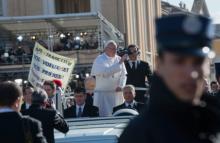
VATICAN CITY — Pope Francis issued a powerful call for the protection of the environment and of society’s most vulnerable during his formal installation Mass at the Vatican, while qualifying his papal power as a “service” to the church and to humanity.
The pope on Tuesday celebrated a solemn Mass in St. Peter’s Square in front of an estimated 200,000 people, as well as political and religious leaders from all over the world.
During the Mass, Francis received the symbols of his papal authority over the world’s 1.2 billion Roman Catholics: the pallium, a lamb’s wool stole that recalls Jesus as the Good Shepherd, and the “ring of the fisherman.”
In keeping with the low-key style that has been the hallmark of his pontificate so far, Francis presided over a somewhat simpler, and definitely shorter, rite than the one that marked the start of Benedict XVI’s reign in 2005.
Francis was slowly driven around a sun-drenched St. Peter’s Square in an open-top car, shunning the bulletproof, air-conditioned popemobile preferred by his predecessors. At one point, he asked to stop the car and got out to bless a disabled person.
In his homily, delivered in Italian, Francis described the church’s mission as “respecting each of God’s creatures and respecting the environment in which we live.”
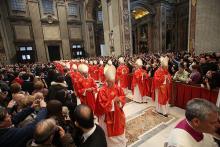
Last Sunday night, the Rev. Thomas Rosica was walking through the Piazza Navona in Rome’s historic center when he bumped into Cardinal Jorge Bergoglio, who he has known for years. Bergoglio was walking alone, wearing a simple black cassock and he stopped and grabbed Rosica’s hands.
He had reason to be worried. Two days later, on Tuesday evening, he and 114 other cardinals entered the conclave to elect a successor to Benedict XVI; a little more than 24 hours and five ballots after that, Bergoglio emerged on the balcony of St. Peter’s Basilica as Pope Francis. “I want you to pray for me,” the Argentine cardinal told Rosica, a Canadian priest who was assisting as a Vatican spokesman during the papal interregnum. Rosica asked him if he was nervous. “A little bit,” Bergoglio confessed.
It was a surprising outcome, and even if Bergoglio suspected something was up, few others did, including many of the cardinals in the Sistine Chapel with him.
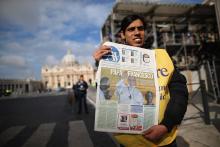
When I heard about the white smoke on Wednesday, I wrote on my Facebook wall: “Habent Papum.” My own church doesn’t use Latin, so I had to use Google translate to figure out how to change the “We have a pope” of “Habemus Papam” into “They have a pope.” I got a few good laughs for my cleverness before a Catholic friend humbly reminded me that it wasn’t just their pope, and that I’d have to deal with him too ... he has no idea how prophetic his words have turned out to be.
You see, I didn’t expect to tune in at all to the election of the pope. I was raised in the Catholic Church and received its early sacraments before my family joined the Episcopal Church (my father’s tradition). I spent plenty of time in high school and after defending its practices and traditions against atheists and Protestant friends and colleagues, and I more than made up for that by pressing hard on my Catholic friends on the nuances I didn’t understand. But mostly I only paid attention when the Catholic Church said something publicly or took a political stand on an issue I cared about.
But on Wednesday, the white smoke got in my eyes, and rather than confusing my sight, it’s made things a little clearer.
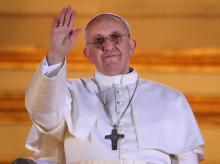
Francis. Pope Francis. This could be good news for the Catholic Church, for the whole church, and for the world. Let’s hope and pray so.
Jorge Bergoglio, the Argentinian cardinal from Buenos Aires, will be the first pope from Latin America and the first outside of Europe in a millennium. That’s good news from the start. And the world is now learning about the 76-year-old new pontiff whose election caused the white smoke to rise in the night skies of Rome to the cheers of tens of thousands of people in St. Peter’s Square. A Jesuit scholar, he seems to be a humble man who lives simply, choosing to live in a small apartment instead of the archbishop’s palace, and travel on buses and trams instead of in the church limousine.
Will simplicity and social justice become the witness of the Roman Catholic Church around the world — and will it emanate from the first pope from the Global South, which is clearly the growing future of the church? What good news that would be.
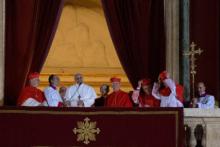
VATICAN CITY — A hierarchy looking to make a clear statement about where the troubled church is headed chose on Wednesday the first member of the influential Jesuit order to be the next pope. Yet they also chose Cardinal Jorge Mario Bergoglio, a humble man who lives simply and took the name Francis (also a first) that evokes the founder of another great religious order.
The College of Cardinals picked the first non-European in modern times, as well – yet he is the son of Italian immigrants and grew up in Argentina, perhaps the most European of any country in Latin America.
And the cardinals above all wanted a pastoral figure who would project an image of vigor and warmth to the world after the eight-year reign of Pope Benedict XVI — an introverted, gaffe-prone German theologian who was 78 when he was elected and retired last month at 85, saddled by the burdens of this very public office.
Yet in his stead they chose a soft-spoken a 76-year-old who has been rapped for rarely cracking a smile — an image that Bergoglio did little to dispel with his low-key introduction as Pope Francis to the expectant crowd in St. Peter’s Square on a rainy Roman evening.
“Buona sera,” Francis said in deliberate, word perfect Italian, with just a slight Spanish accent. “You all know that the duty of the conclave was to give a bishop to Rome. It seems that my brother cardinals have come almost to the ends of the earth to get him … but here we are.”
So what, in fact, does the election of Francis say about the Catholic Church at this point in its history?
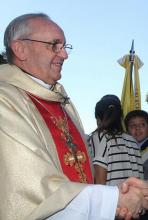
Argentinian Cardinal Jorge Mario Bergoglio was elected as Pope Francis I on Wednesday, after only two days of voting in the conclave tasked with choosing a successor to Pope Benedict XVI.
According to anonymous reports of the 2005 conclave, he was the leading contender against then-Cardinal Joseph Ratzinger, who became Benedict XVI. Bergoglio, 76, has served as the archbishop of Buenos Aires since 1998 and was made a cardinal in 2001. He is the first Latin American and the first Jesuit to rise to the papacy.
In his first address to the huge crowd that had gathered in St Peter’s Square, Francis asked for the prayers of “all men and women of good will” to help him lead the Catholic Church.
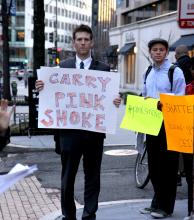
As cardinals in the Vatican wrapped up the first day of the conclave with no decision on the next pope, a small crowd assembled on the steps of the Cathedral of St Matthew the Apostle here in Washington, D.C., with signs, a guitar, and fervent prayers that the conclave would usher in a new openness to women in Catholic leadership.
The chilly March wind rose as volunteers passed around flickering candles. “There’s too much Holy Spirit here tonight,” one organizer joked. “We should tell her to tone it down a bit.”
Those assembled were praying for something popes have long opposed: an active recognition of women as decision-makers in the church.
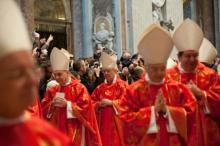
VATICAN CITY — As 115 cardinal-electors solemnly processed into the Sistine Chapel on Tuesday afternoon, with a cry of “Extra omnes!” and the latest high-tech jamming devices cutting them off from the world, the buzz outside the Vatican over who would eventually emerge as pope grew deafening.
Everyone had theories, many had favorites, and most declared it all so unpredictable that the winner – or even how long it would take to find him – was anybody’s guess.
“We are living through an extraordinary conclave,” Marco Tosatti wrote in La Stampa, the Italian daily whose insider coverage of the pre-conclave meetings read like a tip sheet for papal bookies.
“If we look at the history of conclaves over the last century, never has there been such a range of choices, and such uncertainty over the outcome up to the moment that the doors of the Sistine Chapel closed,” he said.
In fact, the latest lines were varied and morphing all the time, a feast of permutations for Vaticanisti who parse papal elections the way sci-fi geeks deconstruct a new installment of “Star Wars.”